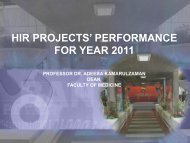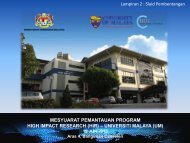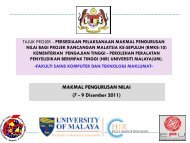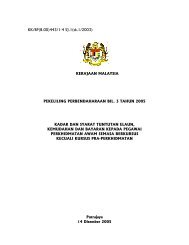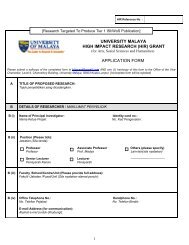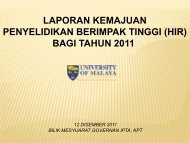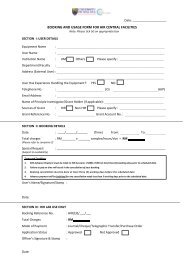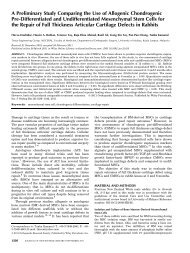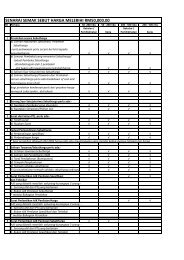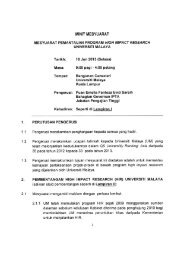Seroprevalence Survey of Chikungunya Virus in Bagan Panchor ...
Seroprevalence Survey of Chikungunya Virus in Bagan Panchor ...
Seroprevalence Survey of Chikungunya Virus in Bagan Panchor ...
Create successful ePaper yourself
Turn your PDF publications into a flip-book with our unique Google optimized e-Paper software.
CHIKUNGUNYA IN BAGAN PANCHOR, MALAYSIA1247Table 2Cl<strong>in</strong>ical features <strong>of</strong> seropositive residents with laboratory-confirmed<strong>Chikungunya</strong> <strong>in</strong>fection ( N = 40)Symptomatic and seropositive cases were reported throughoutthe village, although there were more cases <strong>in</strong> the northwesternhalf by the mouth <strong>of</strong> the river (area B <strong>in</strong> Figure 1 ),which had more dense hous<strong>in</strong>g, the jetty, shops, and restaurants.This was confirmed by multivariate analyses; the only significant<strong>in</strong>dependent demographic predictor <strong>of</strong> both symptomaticdisease and seropositivity was residence <strong>in</strong> area B ( Table 1 ).Other demographics such as age, sex, education background,and occupation were not significant predictors.The cl<strong>in</strong>ical features <strong>of</strong> the 40 seropositive residents areshown <strong>in</strong> Table 2 . Of the 33 symptomatic cases, the most commonsymptoms were arthralgia (90.9%), fever (75.8%), andrash (63.6%). The most frequently affected jo<strong>in</strong>ts were knees,ankles, elbows, and wrists. Of the 30 seropositive cases report<strong>in</strong>garthralgia, 29 stated that jo<strong>in</strong>t symptoms lasted for amedian <strong>of</strong> 14 days (range = 2–100 days).Two (5.0%) seropositive people reported dependence onothers for self-care activities such as us<strong>in</strong>g the toilet and dress<strong>in</strong>g,and one <strong>of</strong> two people required a wheelchair. This dependencewas temporary, last<strong>in</strong>g between 3 and 30 days. Only one<strong>of</strong> the seropositive residents, who had arthralgia symptoms for100 days, reported concurrent depressive symptoms <strong>of</strong> loss <strong>of</strong><strong>in</strong>terest and tiredness; this was <strong>in</strong>sufficient to meet the criteriafor a major depressive episode.DISCUSSIONNumber/total %Asymptomatic 7/40 17.5Symptomatic 33/40 82.5Arthralgia 30/33 90.9Knees 22/30 73.3Ankles 20/30 66.7Elbows 20/30 66.7Wrists 15/30 50.0F<strong>in</strong>gers 12/30 40.0Shoulders 6/30 20.0Sp<strong>in</strong>e 2/30 6.7Fever 25/33 75.8Rash 21/33 63.6Myalgia 16/33 48.5Headache 10/33 30.3Pruritus 8/33 24.2Nausea 1/33 3.0Bleed<strong>in</strong>g 0/33 0This study is the first seroprevalence study to be performed<strong>in</strong> Malaysia s<strong>in</strong>ce the 1960s, when “a very low level <strong>of</strong> populationimmunity” was found <strong>in</strong> the western states, <strong>in</strong>clud<strong>in</strong>gPerak. 10 A total <strong>of</strong> 72 <strong>Bagan</strong> <strong>Panchor</strong> residents were tested,which is higher than the 63 tested dur<strong>in</strong>g the outbreak. 2, 3Compared with the contemporary Indian Ocean outbreaks,the attack rate <strong>in</strong> <strong>Bagan</strong> <strong>Panchor</strong> <strong>of</strong> 55.6% was higher thanthe rates <strong>in</strong> Mayotte 11 and Réunion Island 12 but lower than therates <strong>in</strong> the Comoros 13 and Lamu Island <strong>in</strong> Kenya 14 ( Table 3 ).The <strong>Bagan</strong> <strong>Panchor</strong> rate may overestimate the true attack rate,because symptomatic participants were more likely to agreeto test<strong>in</strong>g than the asymptomatic participants (53.5% versus31.2%; χ 2 = 8.9, P = 0.003). Differences <strong>in</strong> attack rates arelikely caused by local factors, <strong>in</strong>clud<strong>in</strong>g population immunityand genetic susceptibility, vector competence, environmentalsett<strong>in</strong>gs, and effectiveness <strong>of</strong> outbreak control measures.These may also vary with<strong>in</strong> the same locality. We found thatresidence <strong>in</strong> the northwestern half <strong>of</strong> the village, where thema<strong>in</strong> commercial activities and a greater density <strong>of</strong> hous<strong>in</strong>gwere located, predicted symptomatic disease and seropositivity.We did not explicitly study the reasons for this <strong>in</strong> <strong>Bagan</strong><strong>Panchor</strong>, but it is likely that social and environmental factorscontributed. For example, <strong>in</strong> Mayotte, CHIKV seroprevalencewas higher <strong>in</strong> households with structural risk factors for mosquitobreed<strong>in</strong>g or exposure, such as open yards and outdoortoilets. 17 In two neighborhoods <strong>in</strong> Rio de Janeiro, the highestseroprevalence <strong>of</strong> dengue was seen <strong>in</strong> the busiest areas, whereshops, schools, and transport hubs were located. 18The asymptomatic rate <strong>of</strong> 17.5% <strong>in</strong> our sample is with<strong>in</strong> therange <strong>of</strong> 16.7–27.8% reported <strong>in</strong> other studies. 11,12,15,16 This rateis much lower than that <strong>of</strong> dengue, which has asymptomaticrates <strong>of</strong> over 70%. 18, 19 In the present study, 33 <strong>of</strong> 38 (86.8%)symptomatic participants were seropositive, similar to the 53<strong>of</strong> 63 (84.1%) symptomatic cases with laboratory-confirmedCHIKV <strong>in</strong>fection reported dur<strong>in</strong>g the outbreak. 2, 3 Some <strong>of</strong>the suspected cases could be caused by other <strong>in</strong>fections giv<strong>in</strong>gsimilar cl<strong>in</strong>ical symptoms, such as dengue. Symptom-basedsurveillance is, therefore, not enough to accurately determ<strong>in</strong>ethe attack rate dur<strong>in</strong>g CHIKV outbreaks, and asymptomaticpeople must also be tested. Asymptomatic cases wouldhave played a role <strong>in</strong> community transmission, because theywould not be conf<strong>in</strong>ed to their homes like ill cases and wouldrema<strong>in</strong> mobile and active dur<strong>in</strong>g their viremic stage.The acute symptoms reported <strong>in</strong> this study were similar toother outbreaks. Long-term sequelae, especially arthralgia,have been reported <strong>in</strong> uncontrolled studies. 20 However, theonly study to date us<strong>in</strong>g matched controls found that CHIKV<strong>in</strong>fectedpatients had only slightly reduced physical scoresfor quality <strong>of</strong> life, with no impact on medical care received ormental scores. 21 In support <strong>of</strong> this, we found no residual physicaldependence or depression <strong>in</strong> our sample. This supports theTable 3Laboratory-confirmed attack rates and symptomatic:asymptomatic case ratios reported <strong>in</strong> previous CHIKV outbreaksSite (year <strong>of</strong> outbreak) CHIKV genotype *Estimatedpopulation sizeSample size testedfor CHIKV (%) Attack rate (%)Asymptomaticrate (%)Symptomatic:asymptomatic ratioReference<strong>Bagan</strong> <strong>Panchor</strong>, Malaysia (2006) Asian 1,500 72 (4.8) 55.6 17.5 4.7 This studyCastiglione di Cervia, Italy (2007) CEA 2,000 325 (16.3) 10.2 17.9 4.6 15Mayotte (2006) CEA 175,000 1,154 (0.7) 37.2 27.8 2.6 11Réunion Island (2005–2006) CEA 787,836 2,442 (0.3) 38.2 16.7 5.0 12Grande Comore, Comoros (2005) CEA 340,000 331 (0.9) 63 – – 13Lamu Island, Kenya (2004) CEA 18,000 288 (1.6) 75 – – 14Barangay Pulo, Philipp<strong>in</strong>es (1996) Unknown(probably Asian) 500 298 (59.6) 65.5 23.3 3.3 16* CEA = Central/East African.



